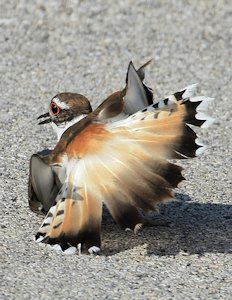
|
Bird Distraction Displays Birds carry out some of their most elaborate behaviors in protecting their nest from predators. Many species of shorebirds combine subtle camouflage patterns of their plumage and their eggs with distraction displays aimed at drawing a predator away from the nest or chicks. The broken-wing display of the Killdeer is a good example of a distraction display that can be observed in areas across North America. When approached by a predator -- including people -- the incubating bird steals away from the nest or flies near the predator and begins calling plaintively, "kill-dee, kill-dee," while squatting and beating one wing against the ground. The bird broadly fans its bright rust-colored tail to lure the predator away from the nest. Any predator looking for an easy catch will surely try for this poor "cripple," which flees just before the predator gets close. The bird then proceeds to move farther from the nest, where it repeats its histrionics. Finding a nest of a Killdeer presents formidable challenges for predators and bird-watchers alike. Its four spotted eggs blend so well with th gravel area on which they sit that they are difficult to find without behavioral clues from the adult bird. The best strategy is to withdraw and watch for the bird to return to the nest. but even this is not without frustration. |
| Killdeer with Distraction Display | |
|
The adult may indulge in "false brooding," sitting on nothing in particular in order to further confuse observers. Many sandpipers on the arctic tundra present similar difficulties to the predator or ornithologist trying to locate nests, often using a rodent-run display, running from the nest while crouching and squeaking like a mouse or lemming. |
|